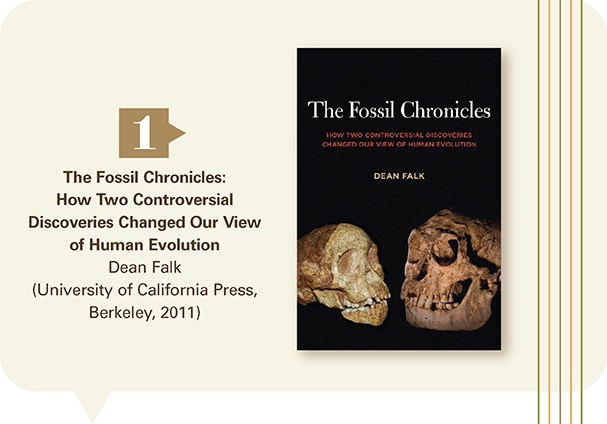This review first appeared in the CHRISTIAN RESEARCH JOURNAL, volume 35, number 06 (2012). The full text of this article in PDF format can be obtained by clicking here. For further information or to subscribe to the CHRISTIAN RESEARCH JOURNAL go to: http://www.equip.org/christian-research-journal/
Human origins are a controversial topic, but not for the reason we commonly hear; for example, that scientific data may pose a challenge to religious views. In The Fossil Chronicles, Dean Falk, an evolutionary anthropologist who specializes in brain anatomy and the evolution of human mental abilities (paleoneurology), gives us a behind-the-scenes look at how new fossils generate heated debate within the secular professional paleoanthropology community when they do not fit into the current human evolutionary model. Her candor and documentation of this internal “acrimoniousness” is refreshing, although she casts stereotypic aspersions at “religious fundamentalist” whipping boys.
Anthropologists have long associated brain size with intelligence, seeing one of the key steps in human evolution as the growth in brain volume from around 300cc in our supposed ancestor primates to over 1,000cc in modern humans. Falk specializes in the magnetic resonance imaging of fossil skulls and in the detailed analysis of brain features that correlate with particular traits (e.g., Broca’s area is associated with speech ability).
The Bewildering Brain. Falk’s book focuses on two hominid fossils where brain features played a key role in their controversial analysis: the recent “Hobbit” (Homo floresiensis) finds in Indonesia and Raymond Dart’s “Taung child,” the first Australopithecus africanus find in South Africa in 1924. For those who don’t mind forays into eye-glazing, highly technical details of brain anatomy, the book is an excellent read and Falk’s autobiographical style very engaging.
The text begins in the early twentieth century, giving the background of the Piltdown Man finds and Dart’s education and early career in England. Because he was seen as overly willing to challenge accepted views among London’s academic aristocracy (not for religious reasons), Dart found himself sent into exile at a teaching position in South Africa.
Falk summarizes the events that led to Dart’s discovery and analysis of a fossil skull of a young child that had a combination of ape and human features no one had seen before. Strikingly, the fossil contained an endocast (a mold of the interior of the skull), which allowed Dart to estimate the child’s brain volume and cranial features. Dart thought that he saw a particular brain fold, the lunate sulcus, at a location that implied that this fossil was an intermediate between chimps and humans.
After publishing his find in Nature and enjoying the initial acceptance of his work, Dart’s fortunes quickly turned sour as the professional anthropology community soon rejected his conclusions as overreaching. The Taung child was dismissed as too apelike to be a credible missing link because its brain size was smaller than expected (especially compared to Piltdown, which everyone accepted at the time), its geological date was too recent, and in the 1920s, Asia, not Africa, was seen as the cradle of humanity. Moreover, everyone recognized the difficulty in deducing adult features from a youthful skull. British publishers therefore refused to print Dart’s extensive manuscript and analysis of the Taung child. Fortunately, through the efforts of Dart’s South African colleague Robert Broom, who spent decades finding numerous adult fossils of Australopithecus africanus, the significance of Dart’s find came to be appreciated in the late 1940s.
Falk then gives her analysis of Dart’s unpublished manuscript and of the Taung child’s endocast. She recognizes that Dart was mistaken in his analysis, agreeing with his critics that the “entire sulcal pattern was apelike” (p. 70). However, she discovered that Dart had found three cortical areas that were more advanced in the child than they are in apes, a fact consistent with Falk’s own work on other africanus endocasts. Unfortunately, Dart’s cortical results were never published.
Hunting the History of the Hobbits. With this background, Falk segues to her work on the virtual endocasts of the fascinating Homo floresiensis finds from the island of Flores in Indonesia. This fossil discovery by Michael Morwood in 2004 rocked the anthropological world because the individuals were smaller than living pygmies, used primitive tools, and appeared to have lived as recently as 17,000 years ago. Of particular interest was their small brain size, around 400cc, about the size of chimpanzees. Tool use by individuals with such a small brain was viewed as a non sequitur among anthropologists.
Falk readably describes the sad way in which the Hobbit fossils were mishandled, her detailed comparison of Hobbit with Homo erectus and modern human endocasts, and her challenges to meet National Geographic video deadlines. With considerable reserve she responds to attacks that the initial Hobbit announcements received from fellow anthropologists, and spends over a chapter answering the challenges that Hobbits had microcephaly or another disease (they did not).
In light of these severe attacks from peers, the response from “religious fundamentalists” to Hobbits is accommodating. Falk expresses surprise that Morwood received no scathing letters or e-mails from “religious conservatives.” Her major issue with “fundamentalists” appears to be their “adamant rejection of the theory that humans evolved from apelike stock by natural selection” (102).
The final two chapters offer an up-to-date appraisal of the hominid fossil evidence and Falk’s insights on how the pieces, particularly Hobbits, fit into the overall puzzle. For those interested in human origins but not terribly concerned about historical background or brain anatomy, this is perhaps the most important section of the book. It is refreshing to see a top anthropologist note the problems with Homo habilus (“it seems to be something of a grab bag” [166]) and recognize the limitations about what can be deduced from only ten partial hominid skeletons that span several million years. In her analysis, Homo erectus has long legs, relatively modern-human body proportions, and although diverse in features, is anatomically distinct from the short-legged and long-armed Australopithecines.
In a refinement from the first reports where Hobbits were viewed as a dwarf Homo erectus that developed after being isolated on the small Indonesian island of Flores, Falk argues that Hobbits follow the Australopithecine body plan, suggesting that they were the dead end of a very early migration to the island of a late Australopithecine around two million years ago. Hobbit’s tool technology is consistent with that early date, being more primitive than Homo erectus, another revision from initial reports. Falk also mentions that Hobbits have unique and bizarre features, such as extremely large, flat feet, which made it difficult for them to run, and which elude categorization.
Falk’s proposal that Hobbits survived in isolation for nearly two million years on a small island, despite later immigrations of Homo erectus and sapiens, is quite surprising, given the dangers that close inbreeding and environmental change impose over such an extended time. While I wonder if the dating methods suggesting the survival of this primitive hominid until only seventeen thousand years ago are correct (not for any personal young-earth motivation), there are folklore accounts of a strange ebu gogo people with striking similarities to Hobbits who lived on the island until the modern human natives killed them off a couple of centuries ago. There are definitely mysteries surrounding Hobbits that remain to be solved. Perhaps DNA can be retrieved from the Hobbit fossils to help resolve these enigmas, or, as Falk hopes, some might stumble out of the bushes.
Identifying Naturalistic Fundamentalism. In her final pages, Falk ponders why “the study of hominin brain evolution (paleoneurology) is an exceptionally contentious subarea of paleoanthropology” (194). She then broadens the question, noting that “when it comes to the subject of human origins, scientists have been every bit as passionate about their convictions as religious fundamentalists are” (194). After dismissing the standard excuses such as academic advancement pressure, she recalls Dart’s own thoughts, that “fundamentalists” and anthropologists “both addressed the same profound questions” (195). Falk concludes, “Perhaps science itself has become the ‘great comforter’ for many dedicated researchers, as well as a perceived way to achieve a type of immortality by contributing to the advancement of their fields. In other words, science may sometimes take the place of religion” (197).
Tensions in human origins are often blamed on “religious fundamentalists” who challenge naturalistic interpretations by insisting on the special creation of humans, but Falk’s book clearly shows this to be a myth—there is plenty of professional infighting to keep the topic contentious even when creationists aren’t around. Thus Falk’s repeated venting against “religious fundamentalists” is distracting to the thesis of the book, like ethnic or racial slurs would be: “religious fundamentalists” are only gnats among camels in human origins debates.
Falk is on the right track when she notes that “science may sometimes take the place of religion,” but I think that the problem is deeper than she may realize. Here are comments Dart made about the immense interest in his Taung child: “It is because every thinking man and woman has weighed through many hours the perplexing problems of ‘Whence have I come? What am I doing? Whither am I going?’ and it is because, amidst a myriad of philosophical hypotheses, science provides concrete and tangible evidence in answer to the first of this fundamental trinity of enquiry, that youth and man alike eagerly scan the writing in the rocks” (54).
But just how “concrete and tangible” is the scientific evidence from paleoanthropology? Apart from the assumption of naturalism, that somehow we got here through strictly unguided Darwinistic processes, what do the fossils (those ten partial skeletons!) really tell us? Falk notes how “religious fundamentalists” today do “carefully read the scientific literature—albeit selectively,” and reports how they accommodate the fossil evidence to their position. But then she chafes that “at the heart of both [young-earth and old-earth creationist] schools is the conviction that humans are different from other animals and that they originated by a supernatural event” (101). If creationists think that the scientific data are compatible with their views, however, then Falk’s own conviction, that humans are animals that originated by purely natural means, must be seen as fundamentally religious as well: it is not something inherent in the data. The problem is not that “science may sometimes take the place of religion,” but that science, by presupposing naturalism when it studies origins, is guided by religious principles when it evaluates the physical evidence, and therefore it necessarily draws [naturalistic] religious conclusions about our origins.
One of Falk’s epigraphs to chapter seven is sobering: “It is disconcerting to realize that as their intellects were shaped and limited by the dogmas—often scientific—of their day, so may the intellect of the modern investigator be shaped by the a priori judgments of his time” (135). Falk’s repeated slurs imply that in paleoanthropology today, a key issue is not the “concrete and tangible” evidence, but the a priori judgments that define which conclusions are “scientific” and which ones are “religious.” Perhaps the next generation of secular anthropologists will be more open to recognizing their own “naturalistic fundamentalism” and tolerate without aspersion those of other religious denominations who want to engage the evidence. There is a lot to learn here and a variety of viewpoints would seem helpful. —John A. Bloom
John A. Bloom, Ph.D., Ph.D., is a professor of physics; chair of the chemistry, physics, and engineering departments; and academic director of the science and religion master’s degree program at Biola University in La Mirada, California.









